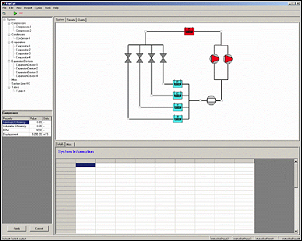VapCyc is an advanced vapor compression cycle simulation and optimization tool
- Choice of charge dependent analysis or
- Suction superheat or condenser sub-cooling based analysis
- Discharge pressure based analysis (trans-critical or supercritical cycles)
- Model validated with experimental data
Different types of cycles (sub-critical and supercritical) can be analyzed
- Basic four-component cycle with and without suction line
- Two-stage split cycle and flash cycle
- Cascade Cycles (solver and validation completed, UI under development)
Ability to change and add system components (evaporator, compressors, etc.) on the fly
- Right-clicking a component gives an option to add a new component before or after the selected component
- Connecting pipes (with and without heat transfer) can also be accounted for
- Continuously growing library of component models
- Accumulators , suction line heat exchanger, two stage compressors, intercooler, fans, pipes and pumps for use in secondary loops
Refrigerants
- All supported refrigerants from NIST REFPROP 7.0/8.0, i.e., R134a, CO2, R410A etc.
- Option to create user-defined refrigerant mixtures on-the-fly
- Option to load use-defined fluid (.FLD) files
Robust Solvers
- Option to choose from three numerical solvers and to change individual solver tolerances
- User can specify starting guess values
- Solvers have been tested on multiple cycle configurations with a variety of operating conditions including off design conditions
Compressor Models
- Simple isentropic efficiency based compressor model
- ARI 10 Coefficient based compressor model. The coefficients are stored in a user-editable Microsoft Access database. Corrections are used for off-design conditions
Heat Exchanger Models
- Simple UA based heat exchanger models (3 zone moving boundary)
- CoilDesigner Heat exchangers can be imported and their geometry and performance can be changed to fit the cycle
- Heat exchangers can be coupled with fan models. Fan models are coefficient based models and are stored in a use editable Microsoft Access database.
Expansion Device Models
- Fixed orifice
- Capillary tubes and short tube orifice
- TXV
Sensitivity / Parametric Studies
- Parametric studies can be conducted by varying a single parameter
- Any independent system or component variable can be changed
- Results can be plotted and exported to spreadsheet
Customization Options
- CEEE Component Standard facilitates the development of user-defined component models
- Component models can be loaded or switched at runtime
- Sample codes and component models are provided along with the program
Optimization Capabilities
- Single and multiobjective genetic algorithms are built-into the program
- The algorithm systematically searches the entire design space defined by the user for optimum cycles that meet certain performance (e.g. COP, cooling capacity, air and refrigerant side pressure drop for heat exchanger etc.) requirements
- Results are displayed as a trade-off (Pareto) set between cost and performance along with the option to view all feasible and infeasible cycle configurations
Support Options
- Support available via email, phone and web-based meetings
- ISOC personnel also assist the users in developing their component models and incorporating them in VapCyc
VapCyc Multiobjective Optimization with Genetic Algorithms (GA)
- Design Options: Tube length, fin density, tube spacing for evaporator and condenser, resulting in a total of 290 million possible vapor compression cycles
- Objective: Minimize Cost and total heat exchanger material volume for fixed system capacity
- The GA evaluated 2700 cycles and produced the trade-off set (Pareto) shown on the right
- For the same COP as the baseline cycle, the cost can be reduced by up to 25 percent or, for the same cost, the COP can be improved by eight percent
Top